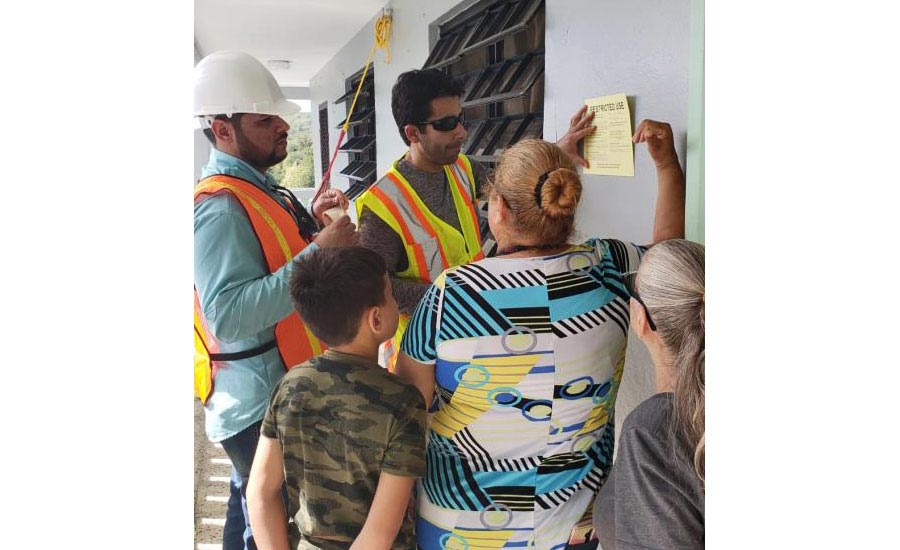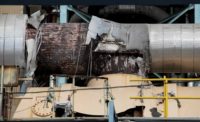Structural engineers Jose A. Sanchez and Eddie M. Guerra, both natives of Puerto Rico, weren’t shocked last week when the College of Engineers and Surveyors of Puerto Rico announced there are some 200,000 non-code-compliant houses on the island that are susceptible to damage in an earthquake. Sanchez, based in San Francisco, and Guerra, based in Houston, weren't at all surprised because they had recently returned from Puerto Rico, where they had seen the devastation caused by the magnitude-6.4 temblor that hit the island on Jan. 7.
The duo, who had met 14 years ago while in engineering school at the University of Puerto Rico, were not back home without a purpose. They were there to mobilize a post-quake building inspection system, which they created as an all-volunteer effort. By Jan. 13, they had four teams of 20 engineers begin their work, in San Sebastian.
On the day of the quake, after seeing photos of the devastation, they decided to take action. They posted a notice on Facebook, inviting other engineers to join their fledgling building-inspection effort. They also invited quake victims to request a building inspection, free of charge. By Jan. 9, the post had been shared 7,600 times.
“We had to use our skills to do something to help,” say Sanchez, a consulting engineer with Simpson Gumpertz & Heger, and Guerra, a senior engineer with Arup. "There was so much suffering."
By Jan. 10, the two had interviewed 80 engineers to determine their experience level and whether they were licensed, before narrowing the group to 30. By Jan. 11, they had five teams ready, with a total of 20 engineers from California, Washington state, Missouri, New Jersey, Florida and Puerto Rico. Each team had a leader licensed in Puerto Rico and experienced with construction inspections.
In parallel, Sanchez and Guerra built an infrastructure for the inspection program, with the help of two local lawyers. This included contacting the mayors and the offices of emergency response of the three initial target towns—San Sebastian, Yuaco and Guanica.
Support was Essential
For each town, the authorities' support was essential. Unlike California, “Puerto Rico had no system, no Good Samaritan law, to deputize the inspectors,” says Sanchez. “We got authorization from each mayor to deputize.”
On Jan. 13, the volunteer engineers started inspections in San Sebastian. Soon, the teams had inspected over 350 houses, including some schools. Of these, more than 100 were found to be “insecure.”
Though Puerto Rico’s earthquake hazard is equivalent to California’s, the last major quake—magnitude-7—was in 1918. There are dozens of weak temblors in Puerto Rico every month, but they are rarely stronger than magnitude 3. However, on Feb. 4, there was a magnitude-5 quake near Guanica, which was hit hard on Jan. 7.
Due to the large response to the inspection program from Puerto Rico's residents, the duo found help to create a website for victims to log in their inspection requests. To date they have received a total of 8,500 requests from people across the island. Nearly 40% are identified as high priority.
Most of the damaged houses are made from unreinforced masonry. Requests for inspection divide into single-story houses, nearly 41%; two-story houses, nearly 30%; and “soft” first-story houses—raised a level on columns, often for parking under the house—nearly 12%. The remaining inspection requests came from other building types, including schools and hospitals, and bridges.
Scrutinized Buildings
The engineers scrutinized buildings using the Applied Technology Council ATC-20 post-quake building evaluation system. Though common in the States, the tagging system had never been used before in Puerto Rico, says Sanchez. A green tag, with the word “inspected" in bold letters,” means lawful occupancy is permitted. A yellow tag, with “restricted use,” means there is damage. The acceptable uses are then specified on the tag. A red tag, with “unsafe,” means do not enter or occupy.
The inspection program also has three collaborators that provide services to the displaced residents: ConPRmetidos, a nonprofit economic development group; Bosque Modelo de Puerto Rico, which is the forest service; and Sociants, a social service agency. In addition, individual volunteers engineers are helping with the website, data management and more.
Though Sanchez and Guerra had returned stateside by Jan. 18, the volunteer inspection effort continues, and has expanded to Guayanilla, Penuellas, Ponce and Lajas. On Feb. 3, Daniel Quinones, of the town's office of emergency management, was overseeing inspections. He paused only long enough to say that the program is a success.
The Sanchez-Guerra ad hoc effort is not the only damage assessment program. The central government had made a request in accordance with Emergency Management Assistance Compact to the state of California. Consequently, 16 Safety Assessment Program (SAP) evaluators from California, along with a coordinator from the California Office of Emergency Services were deployed to Puerto Rico. Evaluators are still on the ground and conducting evaluations as directed by the State, according to the Applied Technology Council.
Editor's note: This article was modified on Feb. 7 to reflect new information.




Post a comment to this article
Report Abusive Comment